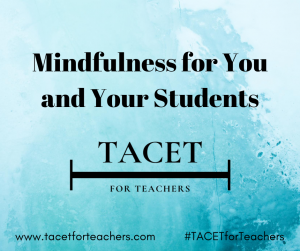As many parts of the US are returning to school this month, it’s understandable that teachers are having feelings of stress and overwhelm. The only thing we know for sure is that this year will be unlike any we have ever experienced before. There are multiple challenges we will face because of new schedules, teaching locations, safety protocols, and more. With that, it is so important that we as music teachers support each other not only in teaching practices but also in self-care. Taking care of ourselves this year will be vital to our success.
One easy (meaning, not overly time consuming or costly) type of self-care is practicing mindfulness. It’s beneficial to both us and our students!

What is Mindfulness?
“Mindfulness means paying attention in a particular way: on purpose, in the present moment, and nonjudgementally.”
Jon Kabat Zinn
“Mindfulness is a way of being, a practice we can engage in. It’s not an abstract state; it’s a kind, nonjudgemental awareness that we try to bring to each moment.”
Meena Srinivasan, Teach, Breath, Learn: Mindfulness In and Out of the Classroom
You’ll notice from these definitions that mindfulness is both something we are and something we do. It’s an intentional awareness. This is an important distinction, as some people think mindfulness entails “clearing their minds” and as a result end up frustrated and giving up because they can’t do so. The other key to mindfulness is being nonjudgemental. Not judging yourself when your mind wanders, for example. Instead, accepting it and moving forward.
When practicing mindfulness you are aware of yourself and what you are doing so fully that you become almost unaware of what’s going on around you. You are present in the moment.
If you are wondering what this has to do with teaching music or self-care, trust that there is a lot!
As music teachers, we often have many things going on at one time. We are in tune with the music and the students. We are anticipating problems. Assessing what just happened. Planning and preparing for what’s next. With so much taking place all at once, we are frequently juggling several tasks at once. By introducing mindfulness practice, we can help ourselves find more focus, be present in the moment, and have a better sense of peace and calming.
The Benefits of Mindfulness
Patricia A. Jennings, the author of Mindfulness for Teachers, identifies the following benefits of mindfulness:
- Helps teachers understand their emotions better
- Helps teachers communicate more effectively with students
- Helps teachers manage difficult students
- Helps teachers create a positive learning environment
- Helps teachers strengthen relationships with students
- Helps teachers slow down when they need to
- Helps teachers build and maintain community
When I think about teaching middle school band, every one of these would benefit my classroom! Music is a creative art. We frequently ask students to be vulnerable in their music-making, so having a positive learning environment, strong relationships, good communication skills, and a sense of community are vital to the success of our programs! (To read more about Patricia’s findings, check out her article, “Seven Ways Mindfulness Can Help Teachers.”)
The benefits don’t stop there. Mindfulness practice also positivity affects our students. Several studies of school students who practice mindfulness have shown improvements in working memory, attention, academic skills, social skills, emotional regulation and self esteem. In addition, many students reported an improvement in their mood and a decrease of anxiety, stress, and fatigue. Thinking about music students, especially those in performance ensembles, mindfulness seems to be a winning addition to what we do.
Over the next few weeks I plan to share specific ways music teachers can incorporate mindfulness practices in their own lives, and into their music classes. Look for posts containing information about meditation, focused breathing, and ways to incorporate mindfulness into daily activities.
As music teachers, our emotional state is transmitted to the students. They can tell if we are upset or angry. They can also tell when we are relaxed and happy. This school year will have its challenges, but when we take time to take care of ourselves, we will be better equipt to handle it.
Can’t wait and want to learn more? Here are some resources for further reading:
